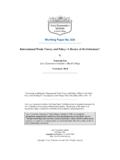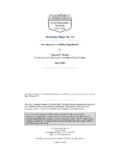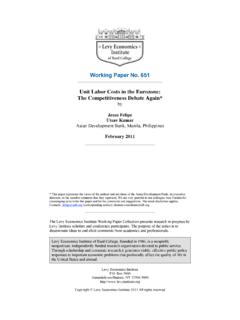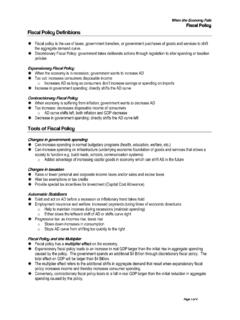Transcription of Fiscal Policy Effectiveness: Lessons from the Great Recession
1 Working Paper No. 649 Fiscal Policy effectiveness : Lessons from the Great Recession by Pavlina R. Tcherneva Levy Economics Institute of Bard College January 2011 The Levy Economics Institute Working Paper Collection presents research in progress by Levy Institute scholars and conference participants. The purpose of the series is to disseminate ideas to and elicit comments from academics and professionals. Levy Economics Institute of Bard College, founded in 1986, is a nonprofit, nonpartisan, independently funded research organization devoted to public service. Through scholarship and economic research it generates viable, effective public Policy responses to important economic problems that profoundly affect the quality of life in the United States and abroad.
2 Levy Economics Institute Box 5000 Annandale-on-Hudson, NY 12504-5000 Copyright Levy Economics Institute 2011 All rights reserved ABSTRACT This paper reconsiders Fiscal Policy effectiveness in light of the recent economic crisis. It examines the Fiscal Policy approach advocated by the economics profession today and the specific Policy actions undertaken by the Bush and Obama administrations. An examination of the labor market renders the contemporary aggregate demand management approach wholly inadequate for achieving certain macroeconomic objectives, such as the stabilization of investment and investor expectations, the generation and maintenance of full employment, and the equitable distribution of incomes. The paper reconsiders the Policy effectiveness of alternative Fiscal Policy approaches, and argues that a Policy that directly targets the labor demand gap (as opposed to the output gap) is far more effective in stabilizing employment, incomes, investment, and balance sheets.
3 Keywords: The Great Recession ; Fiscal Policy ; Macroeconomic Stabilization; Employment JEL Classifications: E24, E25, E65, J08, J6 2 INTRODUCTION To many economists the swift and unequivocal support of the profession for Fiscal activism during the Great Recession has been somewhat of a surprise. After all, since the late 1970s, most mainstream economists had completely abandoned faith in Fiscal Policy effectiveness , largely because of the empirically dubious Ricardian Equivalence Hypothesis (see Barro 1974). Nevertheless, here we are, more than two years after the global financial meltdown of September 2008, in a position to reconsider the role and place of Fiscal Policy in stabilizing a devastated economy. The economist who provided the raison d' tre for countercyclical Fiscal Policy was John Maynard Keynes, whose revolutionary theory (1964 [1936]) transformed the way we understand the functioning of the economy.
4 In reassessing the proper role of Fiscal Policy today, it should be remembered that Keynes inextricably linked the goal of macroeconomic stabilization to the goal of full employment. He had a very narrow definition of full employment and argued that policymakers had a responsibility to ensure that everything that could humanly be done has been done by the state .. [to produce] a reduction of the unemployed to the sort of levels we are experiencing in is to say, an unemployed level of less than 1 per cent unemployed (Keynes 1980: 303). This is the definition of full employment that will be used in this paper and I shall argue that achieving and maintaining this level, while simultaneously stabilizing the business cycle, is possible if we carefully heed the Keynesian message.
5 The principle objective of Fiscal Policy according to Keynes was to solve the real problem, fundamental yet essentially [namely] to provide employment for everyone (Keynes 1980: 267). This objective was nevertheless gradually abandoned by the political process and much of academic economic analysis. Instead, the goal of modern Fiscal Policy has largely been confined to stabilizing incomes, consumption, and investment, whereas employment stabilization is left to be determined as a byproduct of these policies. Keynes, by contrast, believed that the unemployment problem should be solved speedily and directly by one primary method direct job creation through public works. This paper argues that the original Keynesian message can provide both a crucial tool for dealing with the Great Recession and a Policy for addressing the unemployment problem at all phases of the business cycle.
6 In particular, it makes the case that conventional aggregate demand 3 management policies are inadequate for dealing with the unemployment problem during recessions and incapable of achieving true full employment in expansions. The paper will examine the kinds of Fiscal responses that are generally favored by modern economists and policymakers today, as well as the specific Policy actions that were undertaken in the United States to deal with Great Recession after the September 2008 financial meltdown. Next, it will overview briefly the labor market conditions in the United States to underscore the inadequacy of the current response. Finally, it will raise and answer the question what is to be done? While there are good reasons to believe that the Fiscal push was too small, this paper will argue that aggregate demand management cannot establish what Keynes called a closer approximation of full employment as nearly as is practicable (Keynes 1964 [1936]: 378 79).
7 Instead, it suggests that what is required is a fundamental reorientation of Fiscal Policy from one that attempts to close the output gap to one that aims to close the labor demand gap. This approach circumvents a series of shortcomings associated with the aggregate demand management approach. It is a direct approach that delivers macroeconomic stability and addresses the problems of urban blight and rural poverty with its strong regional emphasis. It is a Policy that solves the unemployment problem over the long run because it specifically tackles its cyclical, structural, and seasonal components, as well as the problems of the long-term unemployed, the unemployable, the working poor, and the new entrants in the labor market. MODERN Fiscal Policy AND THE Great Recession The Conventional View Most contemporary economists use the leaky bucket analogy to explain how Fiscal Policy works.
8 Government increases spending for the purposes of boosting GDP growth sufficiently to reduce unemployment to desired levels. Because the Fiscal stimulus enters the economy through a leaky bucket ( , some of it is lost in transit because of administrative costs and some of it, such as tax cuts and certain investment subsidies, has no direct job-creation effect), not all of the money reaches the poor and unemployed. This leaky-bucket analogy comes from the work of Arthur M. Okun, the economist who inspired the economic law that motivates this Policy approach. Okun s Law states that a 1 percent increase in unemployment would generate an approximate 3 percent decline in GDP growth. This relationship has been flipped and used as a 4 Policy guide that lends support to broad-based, pro-growth policies.
9 The law indicates that unemployment can be reduced if the government manages to stimulate growth at a fast enough rate. Note that 3 percent growth in actual GDP (relative to potential output) brings about only a 1 percent reduction in unemployment a rather small and unimpressive effect (Okun [1962] himself cautioned that the GDP-to-unemployment relationship is rather weak). Although economists generally accept the inverse relationship between growth and unemployment, the exact empirical form of this relationship has received widespread criticism (Altig, Fitzgerald, and Rupert 1997; Lee 2000). From a Policy perspective the law does not provide a good guide for government action, even though it motivates the aggregate demand approach. This is because it is unclear what rate or type of growth is required to produce sizeable reductions in unemployment, much less anything close to genuine full employment.
10 Fiscal Policy during the Great Recession Despite the small employment effect stipulated by Okun s law, the general agreement across the theoretical spectrum is that boosting aggregate demand is the proper objective. There is some disagreement on the exact method by which aggregate demand can be expanded, but generally the Policy response would include an automatic and a discretionary component. Government spending expands automatically in recessions with the increase in unemployment insurance, welfare benefits, and other transfers to the jobless and the poor. In addition, tax revenues decline with the fall in economic activity, thus boosting the countercyclical government deficit. Furthermore, a number of discretionary moves can be undertaken to hasten the recovery.



















